UPD's Corporate Growth Strategies and Social Responsibility Report
VerifiedAdded on 2023/06/11
|9
|1606
|62
Report
AI Summary
This report analyzes Unos Property Development's (UPD) corporate strategies and corporate social responsibility (CSR), focusing on water and energy efficiency in their ‘Perth Skies Development’ project. It assesses the company's growth strategies, including the use of mobile apps for data collection, heat mapping, and microgrids for energy savings. The report also evaluates UPD's CSR initiatives, such as using renewable energy sources and implementing water conservation technologies. Recommendations are provided to enhance the company's sustainability practices, including standardized environmental reporting, supply chain transparency, and the implementation of grey water reuse mechanisms. The report concludes by emphasizing the importance of addressing resource scarcity and limiting the negative environmental impacts of commercial activities.
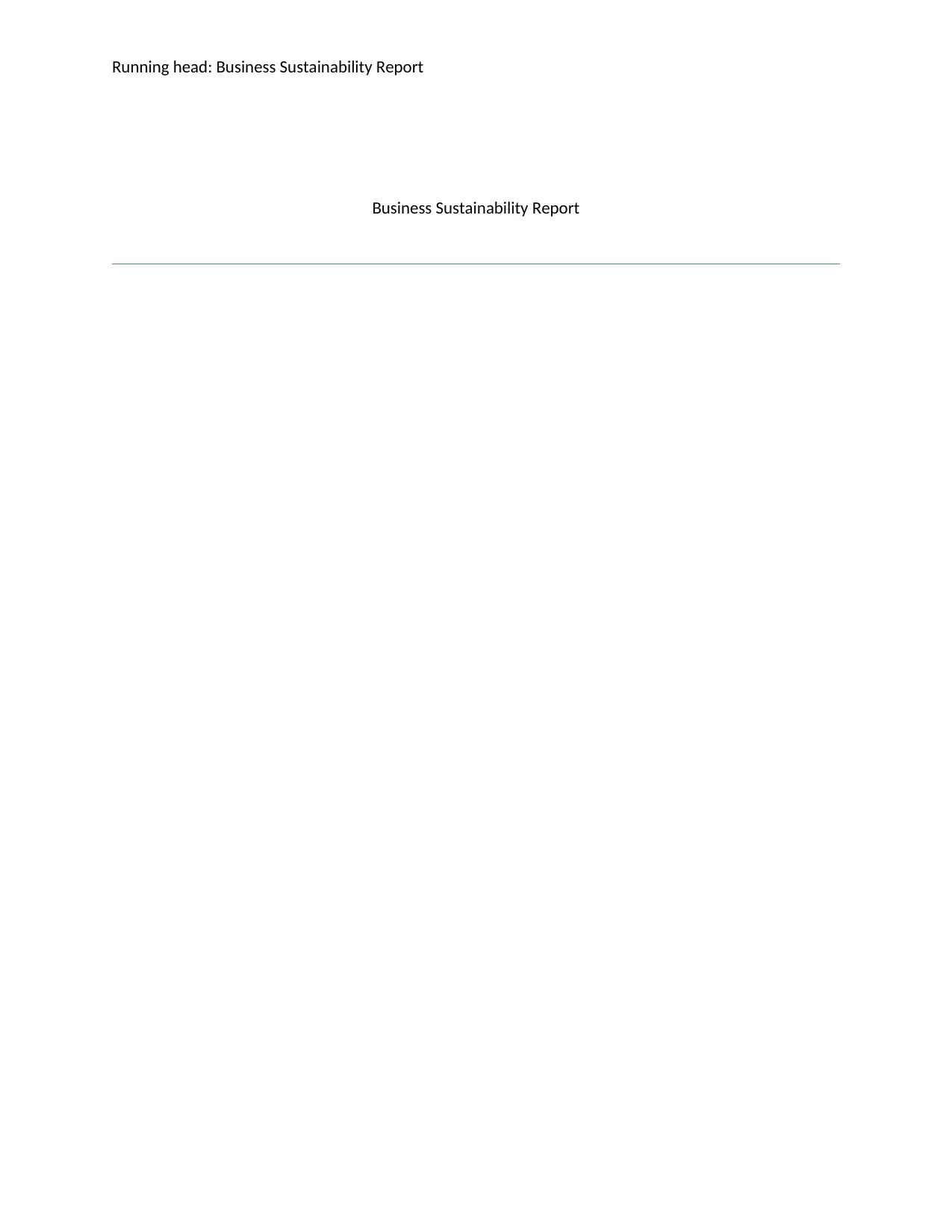
Running head: Business Sustainability Report
Business Sustainability Report
Business Sustainability Report
Paraphrase This Document
Need a fresh take? Get an instant paraphrase of this document with our AI Paraphraser
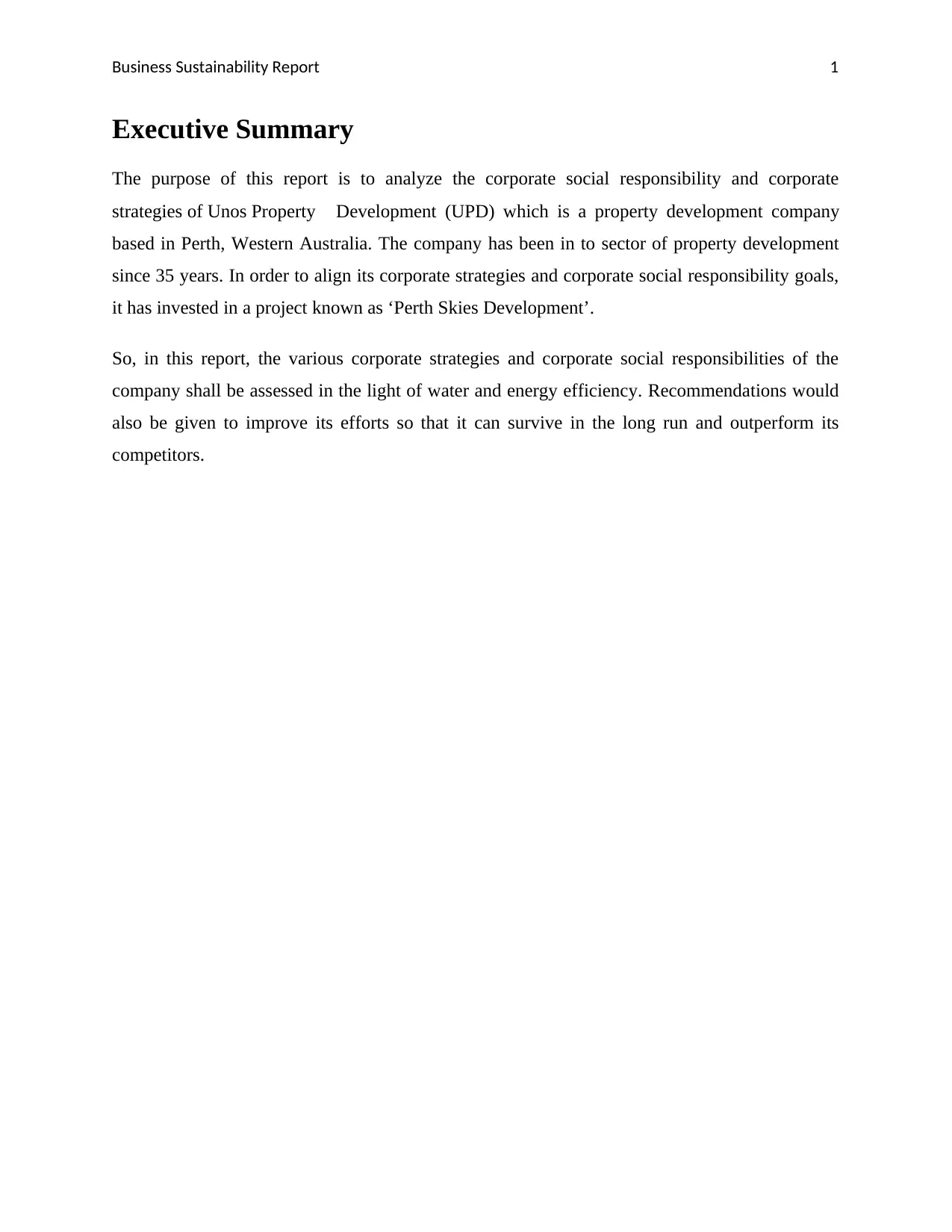
Business Sustainability Report 1
Executive Summary
The purpose of this report is to analyze the corporate social responsibility and corporate
strategies of Unos Property Development (UPD) which is a property development company
based in Perth, Western Australia. The company has been in to sector of property development
since 35 years. In order to align its corporate strategies and corporate social responsibility goals,
it has invested in a project known as ‘Perth Skies Development’.
So, in this report, the various corporate strategies and corporate social responsibilities of the
company shall be assessed in the light of water and energy efficiency. Recommendations would
also be given to improve its efforts so that it can survive in the long run and outperform its
competitors.
Executive Summary
The purpose of this report is to analyze the corporate social responsibility and corporate
strategies of Unos Property Development (UPD) which is a property development company
based in Perth, Western Australia. The company has been in to sector of property development
since 35 years. In order to align its corporate strategies and corporate social responsibility goals,
it has invested in a project known as ‘Perth Skies Development’.
So, in this report, the various corporate strategies and corporate social responsibilities of the
company shall be assessed in the light of water and energy efficiency. Recommendations would
also be given to improve its efforts so that it can survive in the long run and outperform its
competitors.
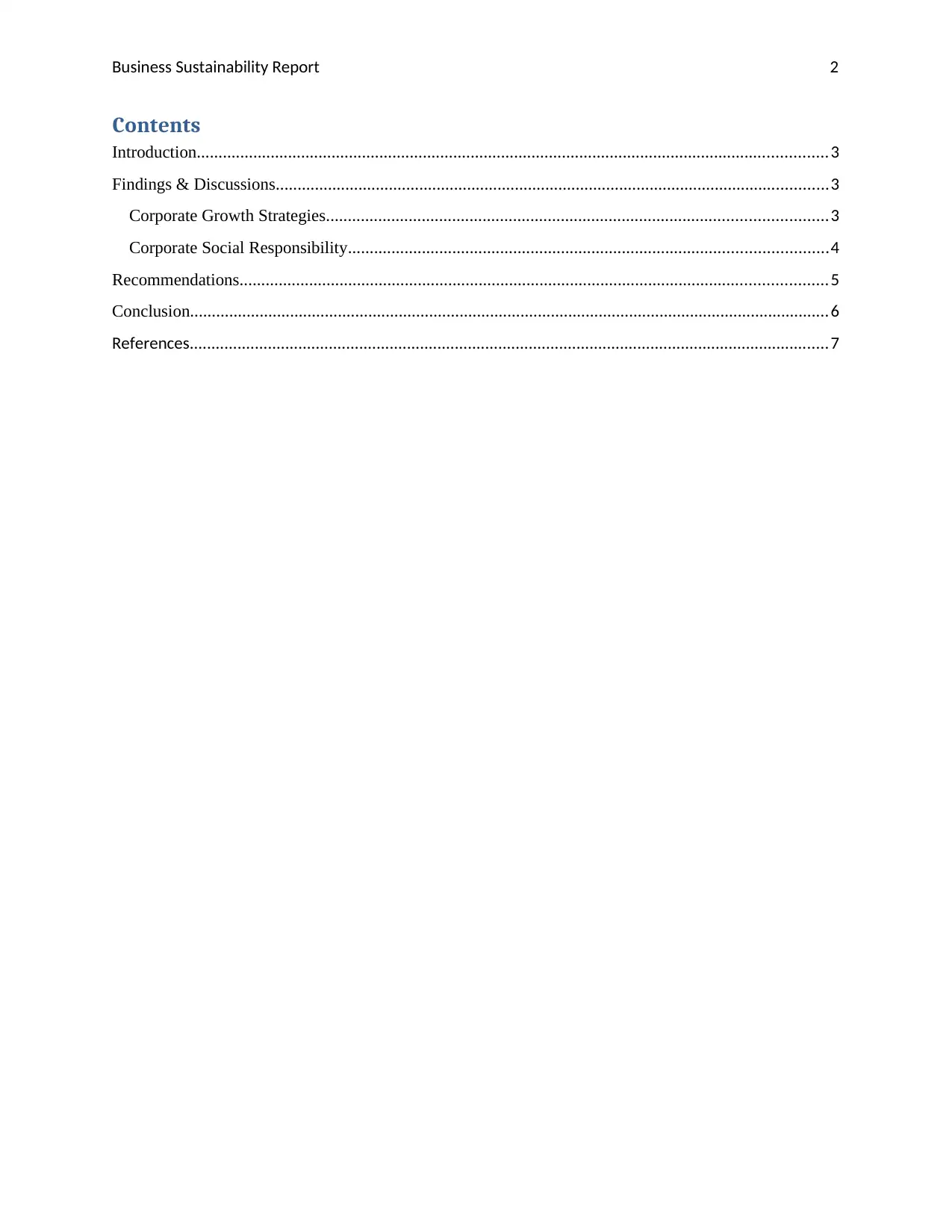
Business Sustainability Report 2
Contents
Introduction.................................................................................................................................................3
Findings & Discussions...............................................................................................................................3
Corporate Growth Strategies...................................................................................................................3
Corporate Social Responsibility..............................................................................................................4
Recommendations.......................................................................................................................................5
Conclusion...................................................................................................................................................6
References...................................................................................................................................................7
Contents
Introduction.................................................................................................................................................3
Findings & Discussions...............................................................................................................................3
Corporate Growth Strategies...................................................................................................................3
Corporate Social Responsibility..............................................................................................................4
Recommendations.......................................................................................................................................5
Conclusion...................................................................................................................................................6
References...................................................................................................................................................7
⊘ This is a preview!⊘
Do you want full access?
Subscribe today to unlock all pages.

Trusted by 1+ million students worldwide
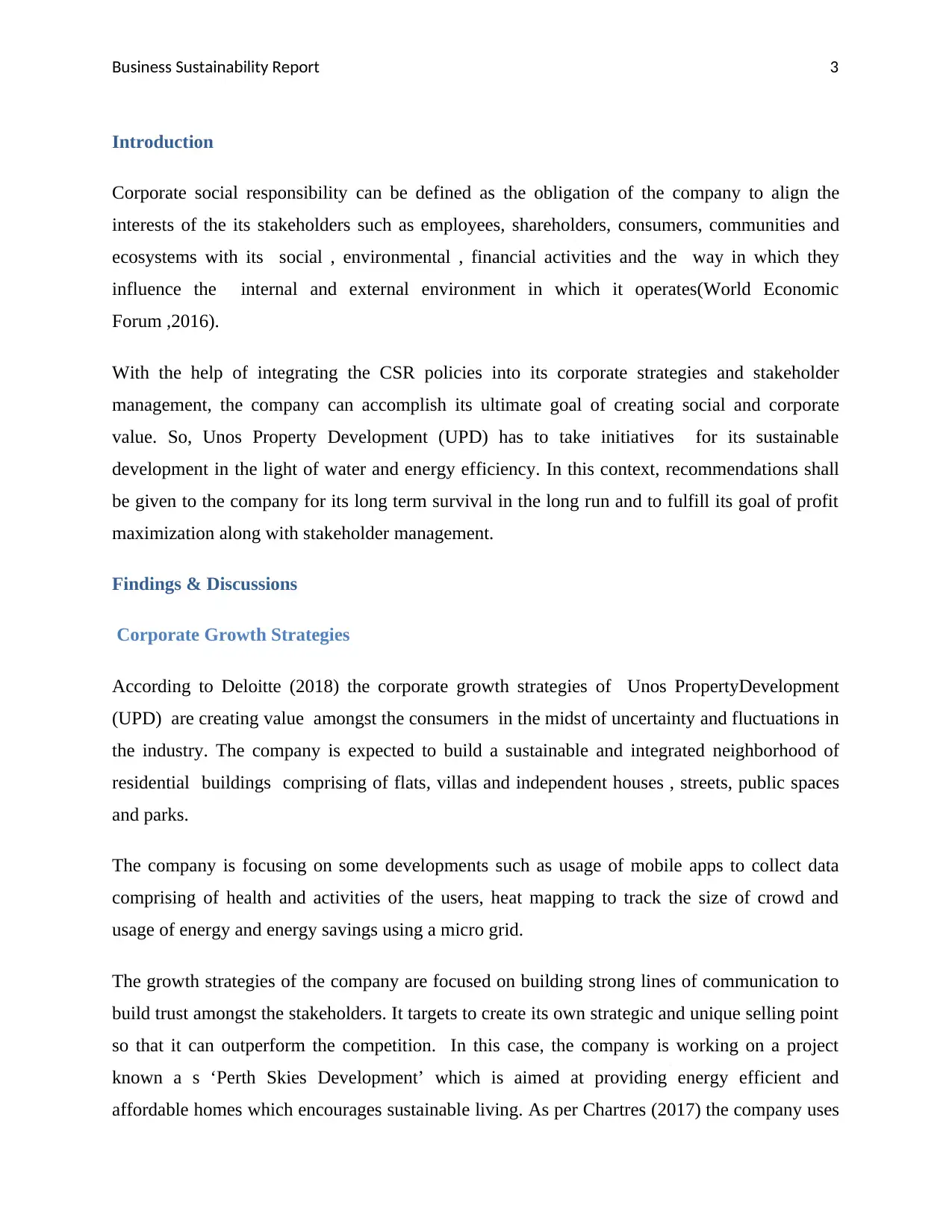
Business Sustainability Report 3
Introduction
Corporate social responsibility can be defined as the obligation of the company to align the
interests of the its stakeholders such as employees, shareholders, consumers, communities and
ecosystems with its social , environmental , financial activities and the way in which they
influence the internal and external environment in which it operates(World Economic
Forum ,2016).
With the help of integrating the CSR policies into its corporate strategies and stakeholder
management, the company can accomplish its ultimate goal of creating social and corporate
value. So, Unos Property Development (UPD) has to take initiatives for its sustainable
development in the light of water and energy efficiency. In this context, recommendations shall
be given to the company for its long term survival in the long run and to fulfill its goal of profit
maximization along with stakeholder management.
Findings & Discussions
Corporate Growth Strategies
According to Deloitte (2018) the corporate growth strategies of Unos PropertyDevelopment
(UPD) are creating value amongst the consumers in the midst of uncertainty and fluctuations in
the industry. The company is expected to build a sustainable and integrated neighborhood of
residential buildings comprising of flats, villas and independent houses , streets, public spaces
and parks.
The company is focusing on some developments such as usage of mobile apps to collect data
comprising of health and activities of the users, heat mapping to track the size of crowd and
usage of energy and energy savings using a micro grid.
The growth strategies of the company are focused on building strong lines of communication to
build trust amongst the stakeholders. It targets to create its own strategic and unique selling point
so that it can outperform the competition. In this case, the company is working on a project
known a s ‘Perth Skies Development’ which is aimed at providing energy efficient and
affordable homes which encourages sustainable living. As per Chartres (2017) the company uses
Introduction
Corporate social responsibility can be defined as the obligation of the company to align the
interests of the its stakeholders such as employees, shareholders, consumers, communities and
ecosystems with its social , environmental , financial activities and the way in which they
influence the internal and external environment in which it operates(World Economic
Forum ,2016).
With the help of integrating the CSR policies into its corporate strategies and stakeholder
management, the company can accomplish its ultimate goal of creating social and corporate
value. So, Unos Property Development (UPD) has to take initiatives for its sustainable
development in the light of water and energy efficiency. In this context, recommendations shall
be given to the company for its long term survival in the long run and to fulfill its goal of profit
maximization along with stakeholder management.
Findings & Discussions
Corporate Growth Strategies
According to Deloitte (2018) the corporate growth strategies of Unos PropertyDevelopment
(UPD) are creating value amongst the consumers in the midst of uncertainty and fluctuations in
the industry. The company is expected to build a sustainable and integrated neighborhood of
residential buildings comprising of flats, villas and independent houses , streets, public spaces
and parks.
The company is focusing on some developments such as usage of mobile apps to collect data
comprising of health and activities of the users, heat mapping to track the size of crowd and
usage of energy and energy savings using a micro grid.
The growth strategies of the company are focused on building strong lines of communication to
build trust amongst the stakeholders. It targets to create its own strategic and unique selling point
so that it can outperform the competition. In this case, the company is working on a project
known a s ‘Perth Skies Development’ which is aimed at providing energy efficient and
affordable homes which encourages sustainable living. As per Chartres (2017) the company uses
Paraphrase This Document
Need a fresh take? Get an instant paraphrase of this document with our AI Paraphraser
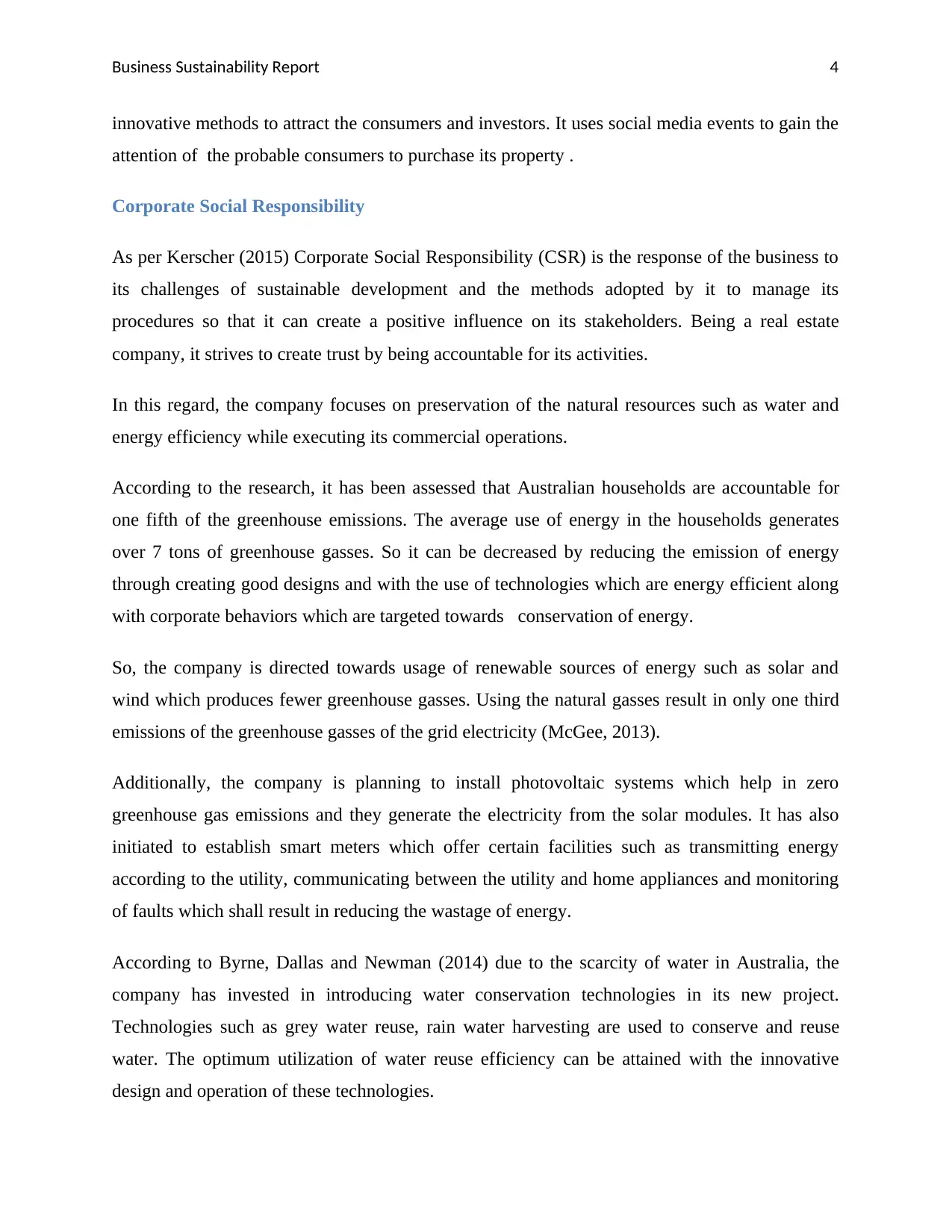
Business Sustainability Report 4
innovative methods to attract the consumers and investors. It uses social media events to gain the
attention of the probable consumers to purchase its property .
Corporate Social Responsibility
As per Kerscher (2015) Corporate Social Responsibility (CSR) is the response of the business to
its challenges of sustainable development and the methods adopted by it to manage its
procedures so that it can create a positive influence on its stakeholders. Being a real estate
company, it strives to create trust by being accountable for its activities.
In this regard, the company focuses on preservation of the natural resources such as water and
energy efficiency while executing its commercial operations.
According to the research, it has been assessed that Australian households are accountable for
one fifth of the greenhouse emissions. The average use of energy in the households generates
over 7 tons of greenhouse gasses. So it can be decreased by reducing the emission of energy
through creating good designs and with the use of technologies which are energy efficient along
with corporate behaviors which are targeted towards conservation of energy.
So, the company is directed towards usage of renewable sources of energy such as solar and
wind which produces fewer greenhouse gasses. Using the natural gasses result in only one third
emissions of the greenhouse gasses of the grid electricity (McGee, 2013).
Additionally, the company is planning to install photovoltaic systems which help in zero
greenhouse gas emissions and they generate the electricity from the solar modules. It has also
initiated to establish smart meters which offer certain facilities such as transmitting energy
according to the utility, communicating between the utility and home appliances and monitoring
of faults which shall result in reducing the wastage of energy.
According to Byrne, Dallas and Newman (2014) due to the scarcity of water in Australia, the
company has invested in introducing water conservation technologies in its new project.
Technologies such as grey water reuse, rain water harvesting are used to conserve and reuse
water. The optimum utilization of water reuse efficiency can be attained with the innovative
design and operation of these technologies.
innovative methods to attract the consumers and investors. It uses social media events to gain the
attention of the probable consumers to purchase its property .
Corporate Social Responsibility
As per Kerscher (2015) Corporate Social Responsibility (CSR) is the response of the business to
its challenges of sustainable development and the methods adopted by it to manage its
procedures so that it can create a positive influence on its stakeholders. Being a real estate
company, it strives to create trust by being accountable for its activities.
In this regard, the company focuses on preservation of the natural resources such as water and
energy efficiency while executing its commercial operations.
According to the research, it has been assessed that Australian households are accountable for
one fifth of the greenhouse emissions. The average use of energy in the households generates
over 7 tons of greenhouse gasses. So it can be decreased by reducing the emission of energy
through creating good designs and with the use of technologies which are energy efficient along
with corporate behaviors which are targeted towards conservation of energy.
So, the company is directed towards usage of renewable sources of energy such as solar and
wind which produces fewer greenhouse gasses. Using the natural gasses result in only one third
emissions of the greenhouse gasses of the grid electricity (McGee, 2013).
Additionally, the company is planning to install photovoltaic systems which help in zero
greenhouse gas emissions and they generate the electricity from the solar modules. It has also
initiated to establish smart meters which offer certain facilities such as transmitting energy
according to the utility, communicating between the utility and home appliances and monitoring
of faults which shall result in reducing the wastage of energy.
According to Byrne, Dallas and Newman (2014) due to the scarcity of water in Australia, the
company has invested in introducing water conservation technologies in its new project.
Technologies such as grey water reuse, rain water harvesting are used to conserve and reuse
water. The optimum utilization of water reuse efficiency can be attained with the innovative
design and operation of these technologies.
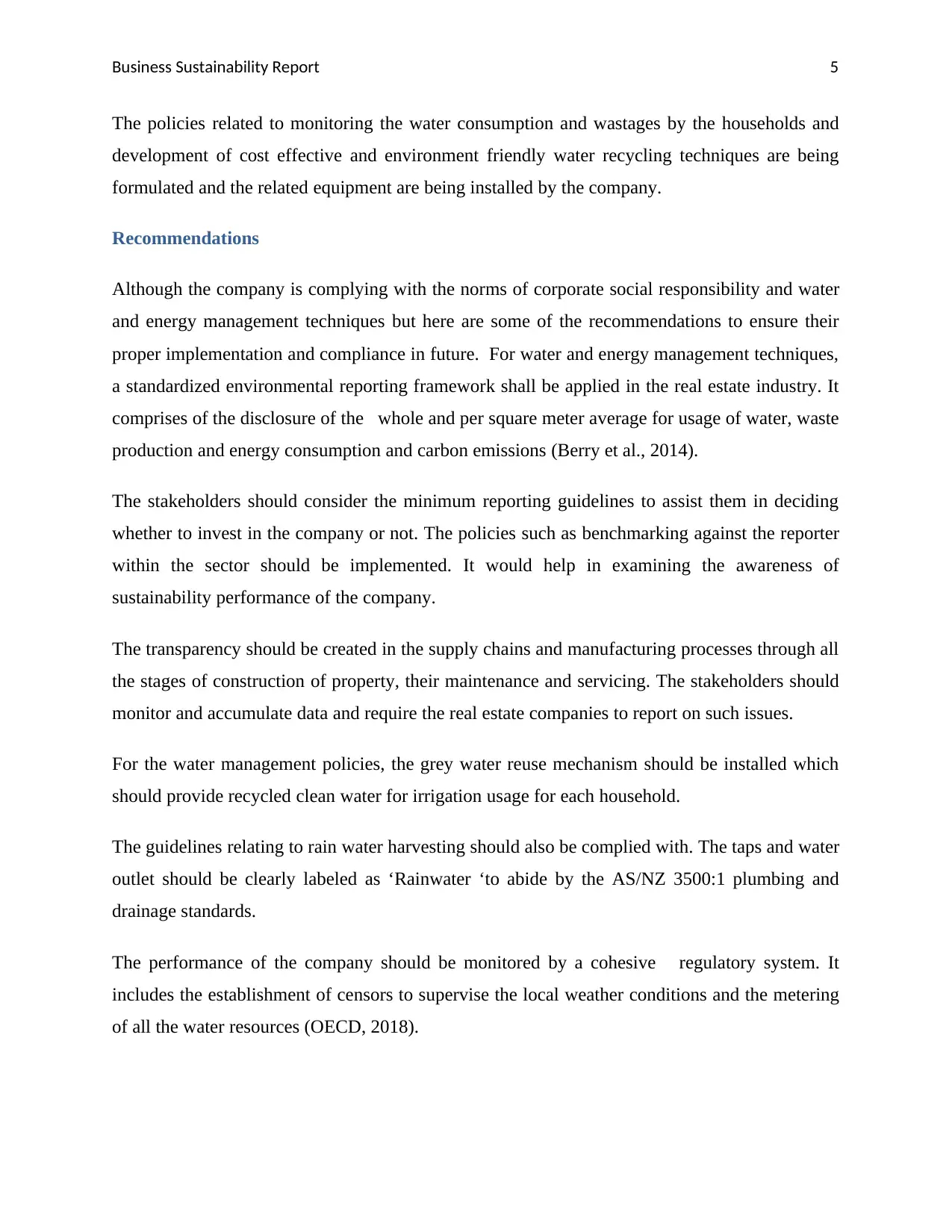
Business Sustainability Report 5
The policies related to monitoring the water consumption and wastages by the households and
development of cost effective and environment friendly water recycling techniques are being
formulated and the related equipment are being installed by the company.
Recommendations
Although the company is complying with the norms of corporate social responsibility and water
and energy management techniques but here are some of the recommendations to ensure their
proper implementation and compliance in future. For water and energy management techniques,
a standardized environmental reporting framework shall be applied in the real estate industry. It
comprises of the disclosure of the whole and per square meter average for usage of water, waste
production and energy consumption and carbon emissions (Berry et al., 2014).
The stakeholders should consider the minimum reporting guidelines to assist them in deciding
whether to invest in the company or not. The policies such as benchmarking against the reporter
within the sector should be implemented. It would help in examining the awareness of
sustainability performance of the company.
The transparency should be created in the supply chains and manufacturing processes through all
the stages of construction of property, their maintenance and servicing. The stakeholders should
monitor and accumulate data and require the real estate companies to report on such issues.
For the water management policies, the grey water reuse mechanism should be installed which
should provide recycled clean water for irrigation usage for each household.
The guidelines relating to rain water harvesting should also be complied with. The taps and water
outlet should be clearly labeled as ‘Rainwater ‘to abide by the AS/NZ 3500:1 plumbing and
drainage standards.
The performance of the company should be monitored by a cohesive regulatory system. It
includes the establishment of censors to supervise the local weather conditions and the metering
of all the water resources (OECD, 2018).
The policies related to monitoring the water consumption and wastages by the households and
development of cost effective and environment friendly water recycling techniques are being
formulated and the related equipment are being installed by the company.
Recommendations
Although the company is complying with the norms of corporate social responsibility and water
and energy management techniques but here are some of the recommendations to ensure their
proper implementation and compliance in future. For water and energy management techniques,
a standardized environmental reporting framework shall be applied in the real estate industry. It
comprises of the disclosure of the whole and per square meter average for usage of water, waste
production and energy consumption and carbon emissions (Berry et al., 2014).
The stakeholders should consider the minimum reporting guidelines to assist them in deciding
whether to invest in the company or not. The policies such as benchmarking against the reporter
within the sector should be implemented. It would help in examining the awareness of
sustainability performance of the company.
The transparency should be created in the supply chains and manufacturing processes through all
the stages of construction of property, their maintenance and servicing. The stakeholders should
monitor and accumulate data and require the real estate companies to report on such issues.
For the water management policies, the grey water reuse mechanism should be installed which
should provide recycled clean water for irrigation usage for each household.
The guidelines relating to rain water harvesting should also be complied with. The taps and water
outlet should be clearly labeled as ‘Rainwater ‘to abide by the AS/NZ 3500:1 plumbing and
drainage standards.
The performance of the company should be monitored by a cohesive regulatory system. It
includes the establishment of censors to supervise the local weather conditions and the metering
of all the water resources (OECD, 2018).
⊘ This is a preview!⊘
Do you want full access?
Subscribe today to unlock all pages.

Trusted by 1+ million students worldwide
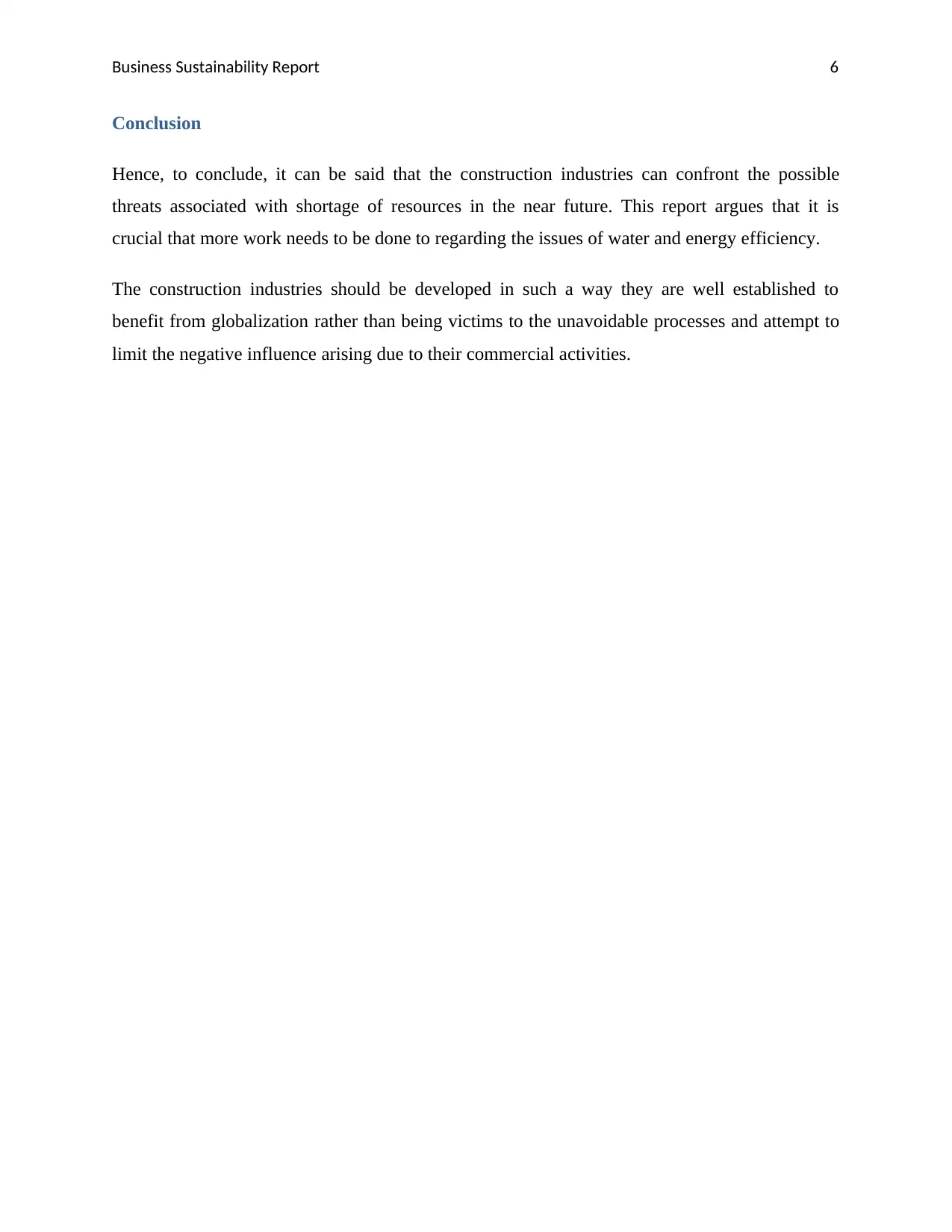
Business Sustainability Report 6
Conclusion
Hence, to conclude, it can be said that the construction industries can confront the possible
threats associated with shortage of resources in the near future. This report argues that it is
crucial that more work needs to be done to regarding the issues of water and energy efficiency.
The construction industries should be developed in such a way they are well established to
benefit from globalization rather than being victims to the unavoidable processes and attempt to
limit the negative influence arising due to their commercial activities.
Conclusion
Hence, to conclude, it can be said that the construction industries can confront the possible
threats associated with shortage of resources in the near future. This report argues that it is
crucial that more work needs to be done to regarding the issues of water and energy efficiency.
The construction industries should be developed in such a way they are well established to
benefit from globalization rather than being victims to the unavoidable processes and attempt to
limit the negative influence arising due to their commercial activities.
Paraphrase This Document
Need a fresh take? Get an instant paraphrase of this document with our AI Paraphraser
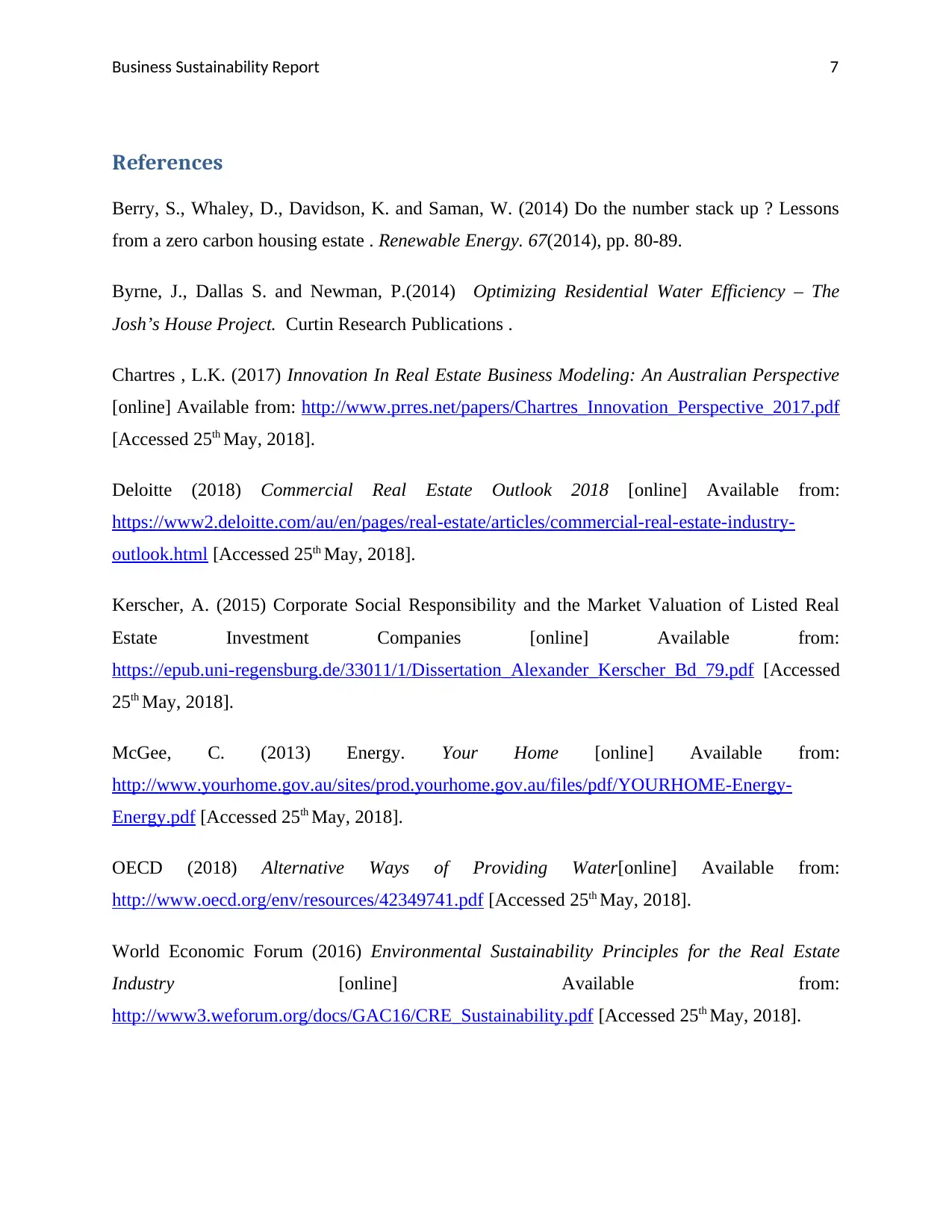
Business Sustainability Report 7
References
Berry, S., Whaley, D., Davidson, K. and Saman, W. (2014) Do the number stack up ? Lessons
from a zero carbon housing estate . Renewable Energy. 67(2014), pp. 80-89.
Byrne, J., Dallas S. and Newman, P.(2014) Optimizing Residential Water Efficiency – The
Josh’s House Project. Curtin Research Publications .
Chartres , L.K. (2017) Innovation In Real Estate Business Modeling: An Australian Perspective
[online] Available from: http://www.prres.net/papers/Chartres_Innovation_Perspective_2017.pdf
[Accessed 25th May, 2018].
Deloitte (2018) Commercial Real Estate Outlook 2018 [online] Available from:
https://www2.deloitte.com/au/en/pages/real-estate/articles/commercial-real-estate-industry-
outlook.html [Accessed 25th May, 2018].
Kerscher, A. (2015) Corporate Social Responsibility and the Market Valuation of Listed Real
Estate Investment Companies [online] Available from:
https://epub.uni-regensburg.de/33011/1/Dissertation_Alexander_Kerscher_Bd_79.pdf [Accessed
25th May, 2018].
McGee, C. (2013) Energy. Your Home [online] Available from:
http://www.yourhome.gov.au/sites/prod.yourhome.gov.au/files/pdf/YOURHOME-Energy-
Energy.pdf [Accessed 25th May, 2018].
OECD (2018) Alternative Ways of Providing Water[online] Available from:
http://www.oecd.org/env/resources/42349741.pdf [Accessed 25th May, 2018].
World Economic Forum (2016) Environmental Sustainability Principles for the Real Estate
Industry [online] Available from:
http://www3.weforum.org/docs/GAC16/CRE_Sustainability.pdf [Accessed 25th May, 2018].
References
Berry, S., Whaley, D., Davidson, K. and Saman, W. (2014) Do the number stack up ? Lessons
from a zero carbon housing estate . Renewable Energy. 67(2014), pp. 80-89.
Byrne, J., Dallas S. and Newman, P.(2014) Optimizing Residential Water Efficiency – The
Josh’s House Project. Curtin Research Publications .
Chartres , L.K. (2017) Innovation In Real Estate Business Modeling: An Australian Perspective
[online] Available from: http://www.prres.net/papers/Chartres_Innovation_Perspective_2017.pdf
[Accessed 25th May, 2018].
Deloitte (2018) Commercial Real Estate Outlook 2018 [online] Available from:
https://www2.deloitte.com/au/en/pages/real-estate/articles/commercial-real-estate-industry-
outlook.html [Accessed 25th May, 2018].
Kerscher, A. (2015) Corporate Social Responsibility and the Market Valuation of Listed Real
Estate Investment Companies [online] Available from:
https://epub.uni-regensburg.de/33011/1/Dissertation_Alexander_Kerscher_Bd_79.pdf [Accessed
25th May, 2018].
McGee, C. (2013) Energy. Your Home [online] Available from:
http://www.yourhome.gov.au/sites/prod.yourhome.gov.au/files/pdf/YOURHOME-Energy-
Energy.pdf [Accessed 25th May, 2018].
OECD (2018) Alternative Ways of Providing Water[online] Available from:
http://www.oecd.org/env/resources/42349741.pdf [Accessed 25th May, 2018].
World Economic Forum (2016) Environmental Sustainability Principles for the Real Estate
Industry [online] Available from:
http://www3.weforum.org/docs/GAC16/CRE_Sustainability.pdf [Accessed 25th May, 2018].

Business Sustainability Report 8
⊘ This is a preview!⊘
Do you want full access?
Subscribe today to unlock all pages.

Trusted by 1+ million students worldwide
1 out of 9
Related Documents
Your All-in-One AI-Powered Toolkit for Academic Success.
+13062052269
info@desklib.com
Available 24*7 on WhatsApp / Email
![[object Object]](/_next/static/media/star-bottom.7253800d.svg)
Unlock your academic potential
Copyright © 2020–2025 A2Z Services. All Rights Reserved. Developed and managed by ZUCOL.




